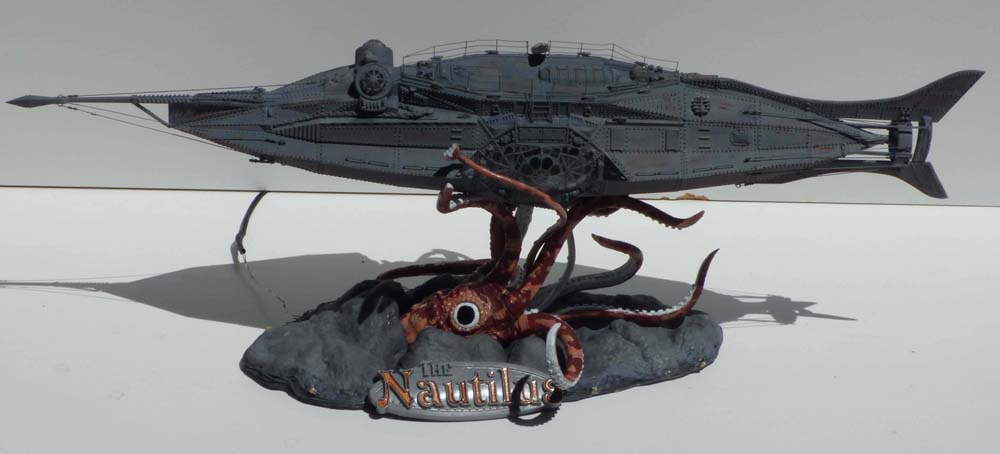
1/144 Jules Verne's Nautilus (Pegasus Hobbies)
|
by Robert Apfelzweig |

1/144 Jules Verne's Nautilus (Pegasus Hobbies)
Most of the people who build model warships have a significant interest in naval history, and although the subject of this display is quite unusual for me, history does play a role in its story. For those of you who fondly remember Disney's 1954 Oscar-winning adventure film, "Twenty Thousand Leagues Under the Sea", the Jules Verne story's remarkable submarine Nautilus was a special effects delight. The current model is "inspired " by the film version of the submarine, in a remake by conceptual designer Greg deSantis, which, as the kit box explains, "combines elements of Civil War era submarines, like the Hunley, with design details reminiscent of Victorian cast-iron architecture." Thus, in the film the submarine's offensive weapon against surface warships was a toothed iron arch over the prow that ripped open the keels of the ships under which the Nautilus propelled itself. In the kit version, the Hunley's use of a (presumably) explosive torpedo projected on a beam at the front of the Nautilus is replicated (although this did not work out well for the unfortunate Hunley). Mr. deSantis chose, fortunately, to include the film's singular special effects creature, a giant squid. The kit directions suggested what colors to paint the squid, and from what I had seen from online photos of an actual living giant squid (one was videotaped off Japan a few years ago), the blotchy maroon, pink and whitish colors are accurate (although squids have chromophores in their skin that allow them to change colors and color patterns on a whim).In any event, the Victorian architectural aspect of this Nautilus is quite evident and very detailed. The cables at the stern of this Nautilus are evidently meant to steer the submarine by angling the propeller rather than the use of a rudder, as the tail fins have no hinges. The only real problem I had in the assembly of the kit was the use of the included adhesive paper covers for the large side windows, which were meant to conceal and protect the clear plastic panes from paint applied by brush or airbrush to the frames on the whole structure (which is in one piece for each window). The adhesive did not fully protect the panes, so that many are smudged with paint (Tamiya Neutral Gray acrylic) that seeped in below the exterior paper cutouts. This has some significance, since the central interior of the submarine, meant to be seen through those windows, contains an assortment of living room-style accoutrements, including a two-sided couch, bookcases, a mounted world globe and, of course, Captain Nemo's pipe organ. The couch, at least. painted to simulate red velvet or leather, can be seen in one of the illuminated photos.
That illumination was a request from the gentleman who commissioned this model. He provided a strand of 25 white LEDs powered by 3 AA batteries in an external case with an on/off button (sold by Lawn and Garden International), and my task was to figure out how to attach and deploy them. Three are used to illuminate the central compartment from above, two more are used for the bubble-like windows forward, about a half dozen LEDs were concealed within the Nautilus's hull (which necessitated careful gluing and painting of the hull seams and openings to eliminate light leakage), and the rest were wrapped around the base of the display and attached with CA glue.
